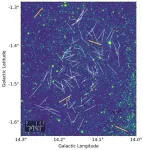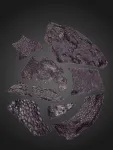(Press-News.org) Embargoed for release until 1:00 p.m. ET on Thursday 11 January 2024
Annals of Internal Medicine Tip Sheet
@Annalsofim
Below please find a summary for new article that will be published in of Annals of Internal Medicine. The summary is not intended to substitute for the full articles as a source of information. This information is under strict embargo and by taking it into possession, media representatives are committing to the terms of the embargo not only on their own behalf, but also on behalf of the organization they represent.
-------------------------------------------------
ACIP releases 2024 Adult Immunization Schedule featuring four new vaccines
Clinicians say communications strategies are needed to increase vaccine uptake among increasingly skeptical patients
Abstract: http://annals.org/aim/article/doi/10.7326/M23-3269
Editorial: http://annals.org/aim/article/doi/10.7326/M23-3452
URL goes live when the embargo lifts
The Advisory Committee on Immunization Practices (ACIP) has released its 2024 Recommended Adult Immunization Schedule that includes four new vaccines. This year, the Schedule includes the respiratory syncytial virus (RSV) vaccine, the mpox vaccine, a new MenACWY-MenB combo vaccine, and updated versions of the COVID vaccine with both an mRNA and a protein-based adjuvanted formulation. The authors say this year’s Schedule is particularly important because many adults are not up-to-date on recommended vaccines. The complete Schedule, including changes in the vaccine notes section, is published simultaneously in Annals of Internal Medicine and in the Center for Disease Control and Prevention’s (CDC) Morbidity and Mortality Weekly Report (MMWR).
Among notable changes in the 2024 Schedule, RSV vaccine is a new addition. For pregnant persons, only Pfizer’s RSV vaccine (Abrysvo) is recommended and should be given to pregnant persons who are 32 weeks through 36 weeks gestation from September through January in most of the continental United States. For patients over the age of 60 years, any approved RSV vaccine can be administered and vaccination is based on shared decision-making. This means that for these patients, RSV vaccination is informed by whether the patient has any risk factors for severe RSV disease; a patient’s risk of exposure to RSV; a patient’s preferences for RSV vaccination; and the clinical discretion of the health care provider. As for COVID-19, all adults are now recommended to receive at least 1 dose of the updated (2023-2024 Formula) COVID-19 vaccine. The number of doses needed and intervals between doses may vary based on a patient’s prior vaccination history, immunocompromised status, and the vaccine product used. For the mpox vaccine, all adults in any age group at increased risk of becoming infected should get a 2-dose series of the vaccine. A complete list of risk factors for mpox is outlined in the Notes section of the Schedule. For polio vaccine, adults who are known or suspected to be unvaccinated or incompletely vaccinated should complete a 3-dose primary series. However, most adults who were born and raised in the United States can assume that they were vaccinated against polio as children unless there are specific reasons to believe they were not vaccinated.
The ACIP Schedule is organized into five separate sections to help physicians find information quickly and easily. Table 1 provides a list of recommended vaccinations by age. Table 2 outlines additional recommended vaccinations by medical condition or other indication. The Notes section highlights vaccine types, dosing frequencies and intervals and considerations for special situations. The Appendix warns of contraindications and precautions for each vaccine in the Schedule, and the Addendum explains new or updated ACIP guidance.
The Schedule is an important reference document for physicians who are struggling to increase vaccination rates in clinical practice. Currently, only 40.8 percent of adults have received an influenza vaccine and rates for the new COVID-19 and RSV vaccines are low at 17.2 percent and 15.9 percent, respectively. According to the authors of a commentary from City University of New York, too many adults are lost to misinformation and distrust of public health, in addition to the concept of “medical freedom” promoted by vaccine skeptics. The authors suggest that recommendations on how to communicate important vaccine messages to patients could be a useful and welcome addition to the Schedule.
The Schedule is published annually to consolidate and summarize updates to ACIP recommendations on vaccination of adults and to assist health care providers in implementing current ACIP recommendations. It is approved by the director of the CDC and by the American College of Physicians, the American Academy of Family Physicians, the American College of Obstetricians and Gynecologists, the American College of Nurse-Midwives, the American Academy of Physician Associates, the American Pharmacist Association, and the Society for Healthcare Epidemiology of America. A video by Dr. Sandra Adamson Fryhofer, MD, MACP explaining ACIP's process, how to use the Schedule, and changes to specific vaccines, will be available at www.acponline.org.
Media notes: For an embargoed PDF please contact Angela Collom at acollom@acponline.org. To speak with CDC’s corresponding author, please email media@cdc.gov. To speak with ACIP liaison, Dr. Sandra Fryhofer, please contact her directly at sandra@drsandrafryhofer.com.
-------------------------------------------------
END
ACIP releases 2024 Adult Immunization Schedule featuring four new vaccines
Clinicians say communications strategies are needed to increase vaccine uptake among increasingly skeptical patients
2024-01-11
ELSE PRESS RELEASES FROM THIS DATE:
Thermal vision shows endangered numbats feel the heat of warming climate
2024-01-11
Curtin University research using thermal imaging of numbats in Western Australia has found that during hot weather the endangered animals are limited to as little as ten minutes of activity in the sun before they overheat to a body temperature of greater than 40°C.
Lead author Dr Christine Cooper, from Curtin’s School of Molecular and Life Sciences, said despite using techniques such as raising or flattening their fur to regulate body temperature, numbats were prone to overheating, which was an important consideration for future conservation efforts, particularly given our warming climate.
“Active only during ...
A call for improved CDC communication on adult immunization
2024-01-11
In an editorial in the Annals of Internal Medicine, CUNY SPH Distinguished Lecturer Scott Ratzan, Senior Scholar Ken Rabin, and colleagues call for the Centers for Disease Control and Prevention (CDC) to “raise its persuasive communications game” on adult immunization to clinicians and the public. They argue that disseminating scientific information alone will not suffice in the present environment of disinformation and low trust in public health.
The editorial is in response to the CDC’s ...
JMIR Biomedical Engineering has passed the Scientific Quality Review by NLM for PMC
2024-01-11
JMIR Publications is pleased to announce that JMIR Biomedical Engineering has passed the Scientific Quality Review by the US National Library of Medicine (NLM) for PubMed Central (PMC). This decision reflects the scientific and editorial quality of the journal. All articles published from 2021 onward will be found on PMC and PubMed after their technical evaluation.
Launched in 2016, JMIR Biomedical Engineering is a sister journal of Journal of Medical Internet Research (the leading open-access journal in health informatics), focused on the application of engineering principles, ...
Close encounters of the supermassive black hole kind: tidal disruption events and what they can reveal about black holes and stars in distant galaxies
2024-01-11
At the center of most large galaxies lives a supermassive black hole (SMBH). The Milky Way has Sagittarius A*, a mostly dormant SMBH whose mass is around 4.3 million times that of the sun. But if you look deeper into the universe, there are vastly larger SMBHs with masses that can reach up to tens of billions of times the mass of our sun.
Black holes grow in mass by gravitationally consuming objects in their near vicinity, including stars. It’s a catastrophic and destructive end for stars unlucky enough to be swallowed by SMBHs, but fortunate for scientists who now have an opportunity to probe otherwise-dormant centers of galaxies.
TDEs Light the Way
As the name ...
Study reveals new connection between impaired autophagy and heart failure
2024-01-11
A new study sheds light on how autophagy, the body’s process for removing damaged cell parts, when impaired, can play a role in causing heart failure. The research team led by Dr. E. Dale Abel, chair of the Department of Medicine at UCLA and Dr. Quanjiang Zhang, adjunct assistant professor of medicine at UCLA, identified a signaling pathway that links autophagy to the control of cellular levels of a key coenzyme known as NAD+, which is found in all living cells and is central to how our metabolism works. Researchers say these findings may have implications ...
Exploring dimethylsulfoniopropionate production by freshwater phytoplankton in lake Baikal
2024-01-11
Phytoplankton or microalgae found in the ocean are often known to produce a sulfur-containing chemical called dimethylsulfoniopropionate (DMSP). This organic molecule breaks down to release a strong but sweet-smelling gas called dimethyl sulfide (DMS), which plays a major role in the formation of cloud condensation nuclei and is also associated with the smell of the sea. More importantly, DMSP acts as an osmolyte and thus protects the phytoplankton against the osmotic pressure created by saline water.
Scientists have, however, ...
Our surprising magnetic galaxy
2024-01-11
A team of astronomers including those from the University of Tokyo created the first-ever map of magnetic field structures within a spiral arm of our Milky Way galaxy. Previous studies on galactic magnetic fields only gave a very general picture, but the new study reveals that magnetic fields in the spiral arms of our galaxy break away from this general picture significantly and are tilted away from the galactic average by a high degree. The findings suggest magnetic fields strongly impact star-forming regions which means they played a part in the creation of our own solar system.
It might come as a surprise to ...
Oldest known fossilized skin is 21 million years older than previous examples
2024-01-11
Researchers have identified a 3D fragment of fossilized skin that is at least 21 million years than previously described skin fossils. The skin, which belonged to an early species of Paleozoic reptile, has a pebbled surface and most closely resembles crocodile skin. It’s the oldest example of preserved epidermis, the outermost layer of skin in terrestrial reptiles, birds, and mammals, which was an important evolutionary adaptation in the transition to life on land. The fossil is described on January 11 in the journal Current Biology along with several other specimens that were collected from the Richards Spur ...
Producing tears in a dish: researchers develop first model of human conjunctiva
2024-01-11
The Organoid group at the Hubrecht Institute produced the first organoid model of the human conjunctiva. These organoids mimic the function of the actual human conjunctiva, a tissue involved in tear production. Using their new model, the researchers discovered a new cell type in this tissue: tuft cells. The tuft cells become more abundant under allergy-like conditions and are therefore likely to play a role in allergies. The organoid model can now be used to test drugs for several diseases affecting the conjunctiva. The study will be published in Cell Stem Cell on 11 January 2024.
Our eyes produce tears to protect themselves from injuries and ...
Palaeontology: New dinosaur species may be closest known relative of Tyrannosaurus rex
2024-01-11
A new species of tyrannosaur from southern North America that may the closest known relative of Tyrannosaurus rex is described in a study published in Scientific Reports.
Sebastian Dalman and colleagues identified the new species — which they have named Tyrannosaurus mcraeensis — by examining a fossilised partial skull, which was previously discovered in the Hall Lake Formation, New Mexico, USA. Although these remains were initially assigned to T. rex and are comparable in size to those of T. rex (which was up to 12 metres long), the authors propose that they belong to a new species due ...
LAST 30 PRESS RELEASES:
Penn researchers awarded $25M to conduct trial using smartphones to fight heart disease
PCORI awards funding for new patient-centered healthcare research
Exploring the origins of the universe: 145 low-noise amplifiers complete ALMA telescopes
Empress cicada wings help illuminate molecular structure
Using sound waves to detect helium
Time burden in patients with metastatic breast and ovarian cancer from clinic and home demands
Researchers discover bias in AI models that analyze pathology samples
Scientists ID potential way to prevent brain injuries from triggering Alzheimer's
MASTER 2nd Open Call: Execution period kick-off
Algae for health in food and pharma
Advanced microrobots driven by acoustic and magnetic fields for biomedical applications
Chicago health information leader recognized for raising CPR readiness and blood pressure awareness
The Intimate Animal, a new book from Kinsey Institute Executive Director Dr. Justin Garcia
When blue-collar workers lose union protection, they try self-employment
New video dataset to advance AI for health care
MEA-based graph deviation network for early autism syndrome signatures in human forebrain organoids
New modeling approach sheds light on rare gut disease
Study documents potentially hazardous flame retardants in firefighter gear
Can certain bacteria regulate aging of the immune system and its related alterations?
AI model helps diagnose often undetected heart disease from simple EKG
There are fewer online trolls than people think
Cell membrane fluctuations produce electricity
Jeonbuk National University study shows positive parenting can protect adolescents against self-harm
Surface-engineered ZnO nanocrystals to tackle perfluoroalkyl substance contamination
This new understanding of T cell receptors may improve cancer immunotherapies
A new fossil face sheds light on early migrations of ancient human ancestor
A new immunotherapy approach could work for many types of cancer
A new way to diagnose deadly lung infections and save lives
40 percent of MRI signals do not correspond to actual brain activity
How brain-inspired algorithms could drive down AI energy costs
[Press-News.org] ACIP releases 2024 Adult Immunization Schedule featuring four new vaccinesClinicians say communications strategies are needed to increase vaccine uptake among increasingly skeptical patients





